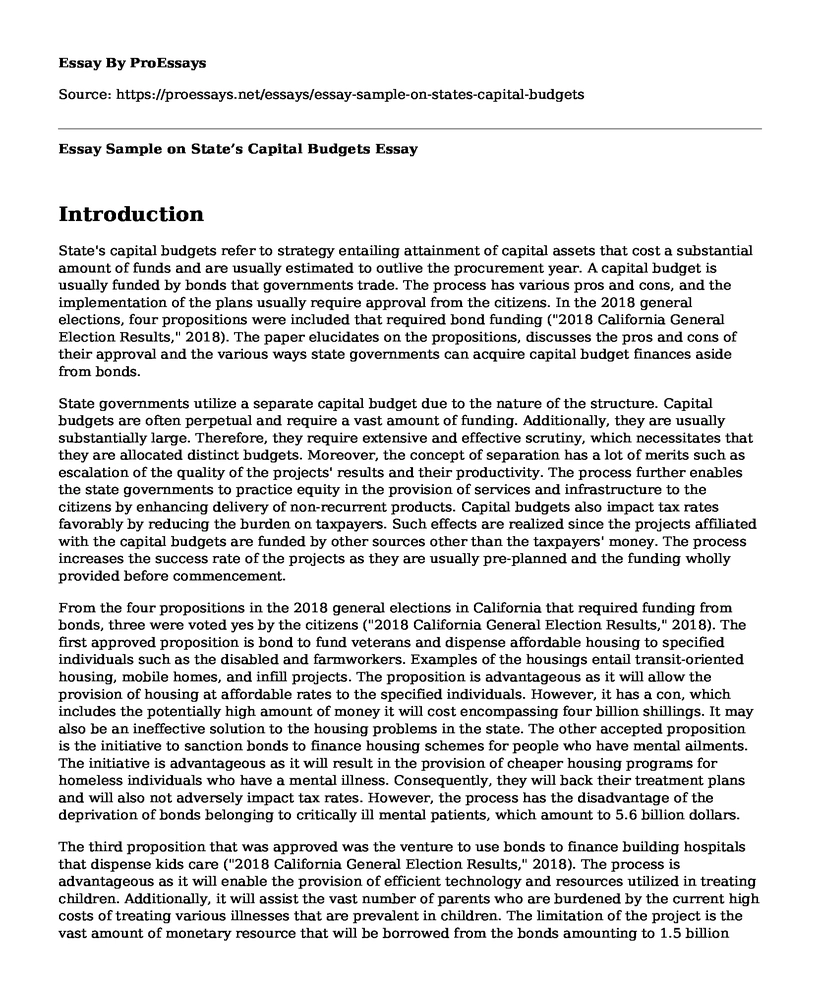Introduction
State's capital budgets refer to strategy entailing attainment of capital assets that cost a substantial amount of funds and are usually estimated to outlive the procurement year. A capital budget is usually funded by bonds that governments trade. The process has various pros and cons, and the implementation of the plans usually require approval from the citizens. In the 2018 general elections, four propositions were included that required bond funding ("2018 California General Election Results," 2018). The paper elucidates on the propositions, discusses the pros and cons of their approval and the various ways state governments can acquire capital budget finances aside from bonds.
State governments utilize a separate capital budget due to the nature of the structure. Capital budgets are often perpetual and require a vast amount of funding. Additionally, they are usually substantially large. Therefore, they require extensive and effective scrutiny, which necessitates that they are allocated distinct budgets. Moreover, the concept of separation has a lot of merits such as escalation of the quality of the projects' results and their productivity. The process further enables the state governments to practice equity in the provision of services and infrastructure to the citizens by enhancing delivery of non-recurrent products. Capital budgets also impact tax rates favorably by reducing the burden on taxpayers. Such effects are realized since the projects affiliated with the capital budgets are funded by other sources other than the taxpayers' money. The process increases the success rate of the projects as they are usually pre-planned and the funding wholly provided before commencement.
From the four propositions in the 2018 general elections in California that required funding from bonds, three were voted yes by the citizens ("2018 California General Election Results," 2018). The first approved proposition is bond to fund veterans and dispense affordable housing to specified individuals such as the disabled and farmworkers. Examples of the housings entail transit-oriented housing, mobile homes, and infill projects. The proposition is advantageous as it will allow the provision of housing at affordable rates to the specified individuals. However, it has a con, which includes the potentially high amount of money it will cost encompassing four billion shillings. It may also be an ineffective solution to the housing problems in the state. The other accepted proposition is the initiative to sanction bonds to finance housing schemes for people who have mental ailments. The initiative is advantageous as it will result in the provision of cheaper housing programs for homeless individuals who have a mental illness. Consequently, they will back their treatment plans and will also not adversely impact tax rates. However, the process has the disadvantage of the deprivation of bonds belonging to critically ill mental patients, which amount to 5.6 billion dollars.
The third proposition that was approved was the venture to use bonds to finance building hospitals that dispense kids care ("2018 California General Election Results," 2018). The process is advantageous as it will enable the provision of efficient technology and resources utilized in treating children. Additionally, it will assist the vast number of parents who are burdened by the current high costs of treating various illnesses that are prevalent in children. The limitation of the project is the vast amount of monetary resource that will be borrowed from the bonds amounting to 1.5 billion dollars, which will be paid back with interest. There are other sources of finances that state governments can use to fund capital budgets such as children's hospitals and affordable housing programs. For instance, stage regimes can acquire grants from the federal government (Gordon, n.d.). Finances from such a source usually have a high rivalry in the acquisition stage. However, they are effectual as the monetary resources dispensed can substantially aid the implementation of the capital budgets. Additionally, state governments can look for equity investors (Gordon, n.d.). Such individuals usually have high interests in the capital projects and are often willing to provide a substantial amount of funds.
Conclusion
In conclusion, capital budgets are usually utilized separately by state governments due to their large size and a substantial amount of funding required. They are usually financed by bonds such as the three approved propositions included in the 2018 general elections in California. The propositions have viable advantages but also have cons, which mainly encompass a large number of bonds they will cost. Other sources of funding for capital budgets entail federal grants and equity investments.
References
2018 California General Election Results. (2018). Retrieved from https://vote.sos.ca.gov/returns/ballot-measures
Gordon, J. (n.d.). Methods for Financing Capital Projects. Small Business - Chron.com. Retrieved from http://smallbusiness.chron.com/methods-financing-capital-projects-77495.html
Cite this page
Essay Sample on State's Capital Budgets. (2022, Nov 05). Retrieved from https://proessays.net/essays/essay-sample-on-states-capital-budgets
If you are the original author of this essay and no longer wish to have it published on the ProEssays website, please click below to request its removal:
- Cryptocurrencies and Blockchain Technologies: Bitcoin and Ripple (XRP)
- Intercom Enterprise Auditing Paper Example
- Amazon Audit Report
- Environmental Taxes Essay Example
- Private Debt Financing: Exceptional Service Grading Company's Options - Essay Sample
- Essay on European Sovereign Debt Crisis: Financial Crisis of 2007-2008.
- Report Example on Cryptocurrency Formation







